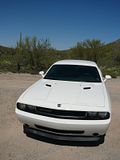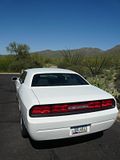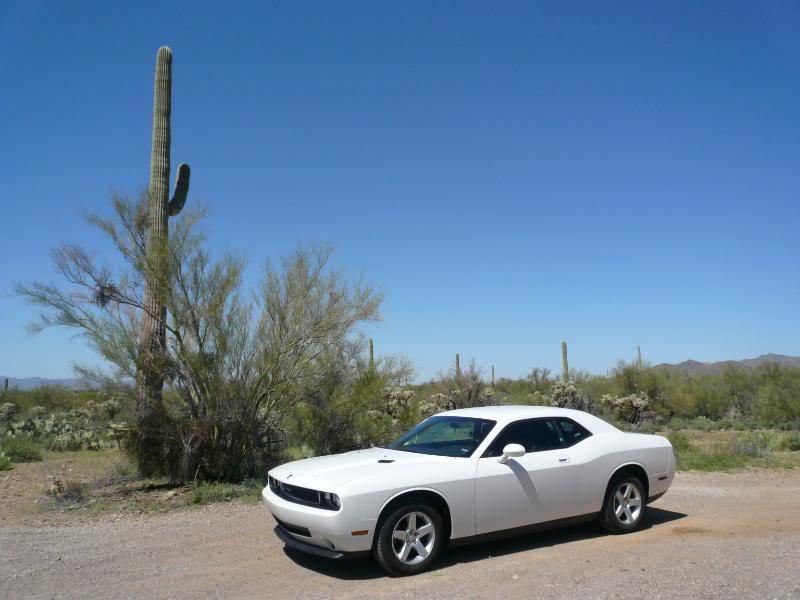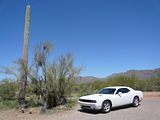
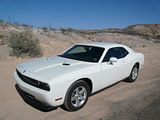
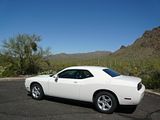
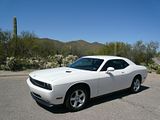
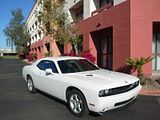
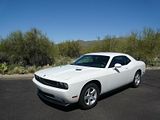 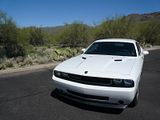

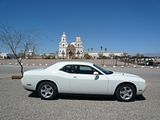
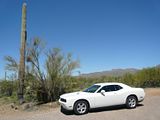
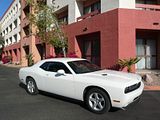
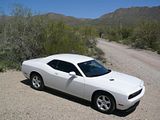
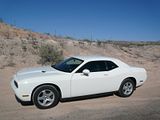
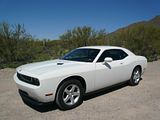
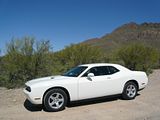
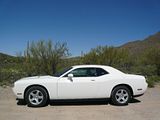
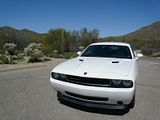
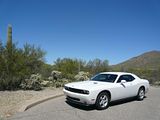
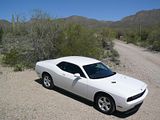
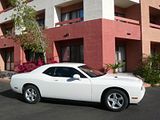
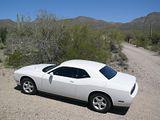
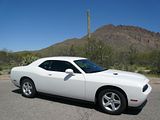



|
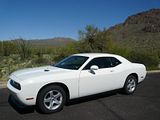 Encouraged, no doubt, by the success of the current generation Ford Mustang, and its wonderful brought up to date retro looks, the Chrysler Corporation looked into their muscle car history section, and decided that they should produce their own competitor. And so, beating GM, who had the same idea with their Camaro, the current Dodge Challenger was born. Paying homage to its much loved early 1970s ancestor, it arrived in the market a year or so earlier than the arch rival from Chevrolet. All three close competitors of Mustang, Camaro and Challenger follow a similar recipe of taking the styling themes of their much loved antecedents, each interpreted in a 21st Century way, meeting all modern safety and other regulatory standards, but underneath using as many standard components from more prosaic models in their range, which helps to keep the prices down. Factor in a large range of models, and the ability to customise your car the way you want, some bright colours, and relatively low prices and you would expect these cars to sell well. Glowing reports from the enthusiastic motoring press who needed no real excuse to tell us how lucky the American market is to have cars like these available again, have indeed helped to fuel even further interest in all three ranges. Not surprisingly, demand has been strong for all three, and it has taken a while for the newer Dodge and Chevrolet to appear in the rental fleets. The V6 engined Mustang has been a staple of car rental-dom for a while, and I have driven the pre-2010 models in both Coupe and Convertible form, as well as the Hertz special edition Shelby GT-H, and each of these models had their appeal. Earlier this year I was able to sample a Camaro SS, and loved every minute of it. So, when Avis at Phoenix Sky Harbor airport offered me a Challenger, I jumped at the chance of completing my sampling of the trio. Encouraged, no doubt, by the success of the current generation Ford Mustang, and its wonderful brought up to date retro looks, the Chrysler Corporation looked into their muscle car history section, and decided that they should produce their own competitor. And so, beating GM, who had the same idea with their Camaro, the current Dodge Challenger was born. Paying homage to its much loved early 1970s ancestor, it arrived in the market a year or so earlier than the arch rival from Chevrolet. All three close competitors of Mustang, Camaro and Challenger follow a similar recipe of taking the styling themes of their much loved antecedents, each interpreted in a 21st Century way, meeting all modern safety and other regulatory standards, but underneath using as many standard components from more prosaic models in their range, which helps to keep the prices down. Factor in a large range of models, and the ability to customise your car the way you want, some bright colours, and relatively low prices and you would expect these cars to sell well. Glowing reports from the enthusiastic motoring press who needed no real excuse to tell us how lucky the American market is to have cars like these available again, have indeed helped to fuel even further interest in all three ranges. Not surprisingly, demand has been strong for all three, and it has taken a while for the newer Dodge and Chevrolet to appear in the rental fleets. The V6 engined Mustang has been a staple of car rental-dom for a while, and I have driven the pre-2010 models in both Coupe and Convertible form, as well as the Hertz special edition Shelby GT-H, and each of these models had their appeal. Earlier this year I was able to sample a Camaro SS, and loved every minute of it. So, when Avis at Phoenix Sky Harbor airport offered me a Challenger, I jumped at the chance of completing my sampling of the trio.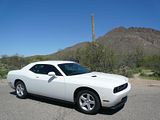  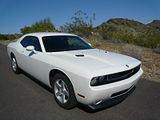
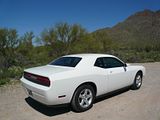 Deciding between Ford, Chevrolet or Dodge is a bit like religion or a favourite sports team to so many people, with so many strong opinions held, and no amount of argumentation likely to persuade a loyal Mustang fan that the other two products might be superior, and vice versa. Hopeful I could at least answer the question for myself, I set off down the long escalator to the ground floor of the rental car centre to go and find “my” Challenger. The paperwork said it was white, and I have to say that this was the first disappointment. I have seen these cars in bold colours such as orange, red and the wonderfully named Plum Crazy. To my mind, those all suit the car’s style rather better than white. That said, it is still a wonderful looking car. On pure looks alone, this car deserves success. The Challenger has been on sale for a couple of years now, and although they are a reasonably common sight, they still attract attention and comment, in a way that the Mustang does not. Before any of the pro-Ford lobby object, I think that is as much to do with the number of Mustangs on the roads versus the number of Challengers. Interestingly, the Camaro is currently outselling the Ford, and these cars are becoming more evident on the roads, too. Back to the Dodge, when I found the car allocated to me, reality dawned on me that the reason why the rental cost was low, was that it was a rental car spec model. The 17″ wheels looked a little lost in the wheel arches, whereas the 18″ and 20″ on the more potent models suit the car so much better. Deciding between Ford, Chevrolet or Dodge is a bit like religion or a favourite sports team to so many people, with so many strong opinions held, and no amount of argumentation likely to persuade a loyal Mustang fan that the other two products might be superior, and vice versa. Hopeful I could at least answer the question for myself, I set off down the long escalator to the ground floor of the rental car centre to go and find “my” Challenger. The paperwork said it was white, and I have to say that this was the first disappointment. I have seen these cars in bold colours such as orange, red and the wonderfully named Plum Crazy. To my mind, those all suit the car’s style rather better than white. That said, it is still a wonderful looking car. On pure looks alone, this car deserves success. The Challenger has been on sale for a couple of years now, and although they are a reasonably common sight, they still attract attention and comment, in a way that the Mustang does not. Before any of the pro-Ford lobby object, I think that is as much to do with the number of Mustangs on the roads versus the number of Challengers. Interestingly, the Camaro is currently outselling the Ford, and these cars are becoming more evident on the roads, too. Back to the Dodge, when I found the car allocated to me, reality dawned on me that the reason why the rental cost was low, was that it was a rental car spec model. The 17″ wheels looked a little lost in the wheel arches, whereas the 18″ and 20″ on the more potent models suit the car so much better.
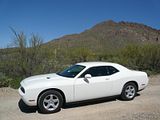 
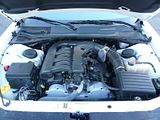 With a mere 250 bhp from the 3.5 litre V6 engine, the SE version of the Challenger is never going to be rapid. And it certainly does not feel it. Opt for the not much more costly (in purchase terms) R/T and you get a 5.7 litre V8 with 372 bhp, or the full fat SRT8 model and you get 425 bhp from a 6.1 litre V8. You would also get the sounds effects to go with it. The SE model is simply too quiet. Whilst this engine might have appeared competitive, on paper, with the soon to be replaced V6 Mustang motor, at least that one sounds good. This one does not sound anything at all. “Civilised” is the word that comes to mind. Trouble is, a car like this should not really be civilised. You expect something that is a bit raw around the edges. It does, however, mean that the Challenger SE is a very refined freeway cruiser, with low cabin noise levels when progressing at freeway speed. Push your foot on the go pedal, and there is an increase in speed, but it is not blisteringly fast. I was a little puzzled by this, as on paper this car has 40 bhp more than the V6 Mustang. Then I looked at their respective weights. This is a heavy car indeed, so no wonder those 250 horses do not seem to go very far. A manual transmission is standard on SE models, but as this was a rental car, it came with the five speed automatic, which provides for smooth gearchanges up and down. A lot of the test mileage was done at steady-ish speeds on the freeway, so the fuel consumption of 25 mpg US is probably about as good as you would ever see, and not punitive on the wallet come refuel time. If the performance was all a little bit tame, then so, sadly are the rest of the driving dynamics. Steering is light, and has reasonable feel, but it is nowhere the standards of the best. The handling felt that little bit untidy, and did not encourage me to push the Challenger that hard in a public place. It does corner without much roll, which is as you would expect, but was rather contrast to the Saturn Outlook I had driven before collecting the Challenger. I found no issues with the brakes, which were light, and effective (unlike the Outlook!). Challenger rides well, so the absence of raw excitement is at least compensated by comfort, as well as the style associated with the shape of the car. That shape does bring its challenges, if you will excuse the rather obvious pun, with visibility. Thick rear pillars, a relatively high window line and high back end mean that judging the extremities of the car are not that easy, as I found when trying to parallel park in a fairly tight spot. The door mirrors do provide a reasonable line of vision for freeway driving, though. With a mere 250 bhp from the 3.5 litre V6 engine, the SE version of the Challenger is never going to be rapid. And it certainly does not feel it. Opt for the not much more costly (in purchase terms) R/T and you get a 5.7 litre V8 with 372 bhp, or the full fat SRT8 model and you get 425 bhp from a 6.1 litre V8. You would also get the sounds effects to go with it. The SE model is simply too quiet. Whilst this engine might have appeared competitive, on paper, with the soon to be replaced V6 Mustang motor, at least that one sounds good. This one does not sound anything at all. “Civilised” is the word that comes to mind. Trouble is, a car like this should not really be civilised. You expect something that is a bit raw around the edges. It does, however, mean that the Challenger SE is a very refined freeway cruiser, with low cabin noise levels when progressing at freeway speed. Push your foot on the go pedal, and there is an increase in speed, but it is not blisteringly fast. I was a little puzzled by this, as on paper this car has 40 bhp more than the V6 Mustang. Then I looked at their respective weights. This is a heavy car indeed, so no wonder those 250 horses do not seem to go very far. A manual transmission is standard on SE models, but as this was a rental car, it came with the five speed automatic, which provides for smooth gearchanges up and down. A lot of the test mileage was done at steady-ish speeds on the freeway, so the fuel consumption of 25 mpg US is probably about as good as you would ever see, and not punitive on the wallet come refuel time. If the performance was all a little bit tame, then so, sadly are the rest of the driving dynamics. Steering is light, and has reasonable feel, but it is nowhere the standards of the best. The handling felt that little bit untidy, and did not encourage me to push the Challenger that hard in a public place. It does corner without much roll, which is as you would expect, but was rather contrast to the Saturn Outlook I had driven before collecting the Challenger. I found no issues with the brakes, which were light, and effective (unlike the Outlook!). Challenger rides well, so the absence of raw excitement is at least compensated by comfort, as well as the style associated with the shape of the car. That shape does bring its challenges, if you will excuse the rather obvious pun, with visibility. Thick rear pillars, a relatively high window line and high back end mean that judging the extremities of the car are not that easy, as I found when trying to parallel park in a fairly tight spot. The door mirrors do provide a reasonable line of vision for freeway driving, though.
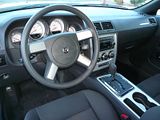  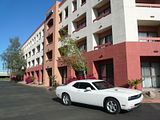 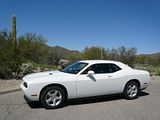 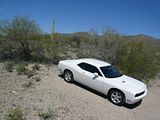
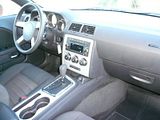 For years, the Chrysler Group products have been deservedly castigated for the substandard quality of their interior design, materials and finish. First impressions of the Challenger were that although it is an improvement on previous products, it is still well below par. Look harder, and this could be almost an unfair criticism, as in fact the plastics used on the dash, whilst not at Audi quality levels, are soft feel to the touch. It is just a shame that they do not look like it. I think the rather angular design of the whole interior does not help. Evidence of poor quality is still there, though, if you look at the gap between the dash moulding and the door trim which is wide enough to insert your finger, and the levels do not line up properly. Ford and GM have made huge strides in recent years, and if Chrysler is going to compete on all fronts, new owners, Fiat, really do have to put some effort into this. The interior is all rather sombre, as almost everything is black. There is some silver trim on the steering wheel, and the centre console which does provide a little visual relief, fortunately. In SE spec, you do not see any cow-hide in the car, with a plastic moulded steering wheel, and cloth seats. That said, neither are particularly bad examples of their art, but they do form yet another reminder that you have the rental car version. There are a few other such signs. For instance, there is a digital clock, but it is a shared display with the station selected on the radio, so you have to press a button to toggle between one or other of these pieces of information. Not exactly earth-shattering, but a bit of a surprise. There is air conditioning, but it is not of the fully automated climate control type. That comes with the R/T model. The dials themselves are clear and easy to read. A single column stalk operates the wipers and indicators, and is mounted a little too low on the left of the column compared to the ideal position. The very obviously Dodge style steering wheel does contain controls for the stereo system and the cruise control. For years, the Chrysler Group products have been deservedly castigated for the substandard quality of their interior design, materials and finish. First impressions of the Challenger were that although it is an improvement on previous products, it is still well below par. Look harder, and this could be almost an unfair criticism, as in fact the plastics used on the dash, whilst not at Audi quality levels, are soft feel to the touch. It is just a shame that they do not look like it. I think the rather angular design of the whole interior does not help. Evidence of poor quality is still there, though, if you look at the gap between the dash moulding and the door trim which is wide enough to insert your finger, and the levels do not line up properly. Ford and GM have made huge strides in recent years, and if Chrysler is going to compete on all fronts, new owners, Fiat, really do have to put some effort into this. The interior is all rather sombre, as almost everything is black. There is some silver trim on the steering wheel, and the centre console which does provide a little visual relief, fortunately. In SE spec, you do not see any cow-hide in the car, with a plastic moulded steering wheel, and cloth seats. That said, neither are particularly bad examples of their art, but they do form yet another reminder that you have the rental car version. There are a few other such signs. For instance, there is a digital clock, but it is a shared display with the station selected on the radio, so you have to press a button to toggle between one or other of these pieces of information. Not exactly earth-shattering, but a bit of a surprise. There is air conditioning, but it is not of the fully automated climate control type. That comes with the R/T model. The dials themselves are clear and easy to read. A single column stalk operates the wipers and indicators, and is mounted a little too low on the left of the column compared to the ideal position. The very obviously Dodge style steering wheel does contain controls for the stereo system and the cruise control.
 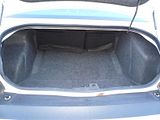 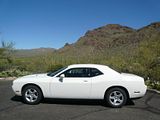 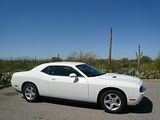 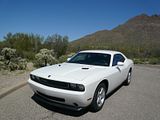
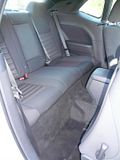 No-one buying this car is going to expect it to be massively practical and readily able to accommodate four or five people and stacks of luggage. In fact, compared with its two principal rivals, this is the one with the most space in the rear seats and the boot. Space in the back of the Challenger is surprisingly good, with ample leg room and enough head room. Three people in there would be tight, but two adults would have no particular shortage of space. They might feel a shortage of light, as the side windows are not very large, though. The boot is a good size, and although the opening is quite narrow between the rear light clusters, it is far larger than in the Camaro or Mustang. Indeed, as I found out later in the trip, I could not get my suitcase through the opening on the Mustang, whereas I had no problems with the Dodge. The boot is a regular shape, and under the flat floor, there is a space saver spare wheel. Inside the cabin, there is some provision for oddments, with rather meagre door pockets which are split into two parts, a rather miserly glove box, and some smaller places to things in the centre console. No-one buying this car is going to expect it to be massively practical and readily able to accommodate four or five people and stacks of luggage. In fact, compared with its two principal rivals, this is the one with the most space in the rear seats and the boot. Space in the back of the Challenger is surprisingly good, with ample leg room and enough head room. Three people in there would be tight, but two adults would have no particular shortage of space. They might feel a shortage of light, as the side windows are not very large, though. The boot is a good size, and although the opening is quite narrow between the rear light clusters, it is far larger than in the Camaro or Mustang. Indeed, as I found out later in the trip, I could not get my suitcase through the opening on the Mustang, whereas I had no problems with the Dodge. The boot is a regular shape, and under the flat floor, there is a space saver spare wheel. Inside the cabin, there is some provision for oddments, with rather meagre door pockets which are split into two parts, a rather miserly glove box, and some smaller places to things in the centre console.
As with its competitors, starting prices for the Challenger are pleasingly low. The entry level SE weighs in at just $22,735. That is certainly a lot of style for not a lot of money. Upgrade to the R/T and you are largely paying for the engine, though you do get bigger wheels (18″), a rear spoiler, sports suspension and a leather-wrapped steering wheel. The SRT8, as well as being supplied with the 6.1 litre V8 Hemi, and a limited slip differential comes with a lot more standard equipment, including heated full leather seats, an upgraded satellite radio, and a number of convenience items.
 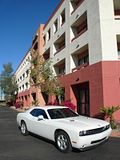  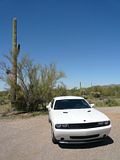  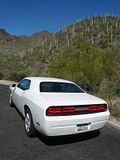 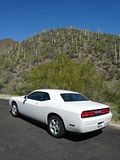
I hate to say it, but I was disappointed by this Challenger. The ingredients are all there, but in SE spec, it is not so much a case of getting the proverbial sheep in wolf’s clothing, as the body in question being a baby lamb. The styling appeals, and I could even live with the interior – though I would prefer an improvement in the quality. But I would be disappointed on a daily basis by the sheer civilised nature of the Challenger SE. I have the feeling that if (when?) I were to sample the R/T, or better still, the SRT8, I might be rather more impressed. As it is, of the three retro pony cars, this one definitely comes at the bottom of the pile, after the Camaro and Mustang. Oh, and not in white, please.
  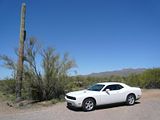 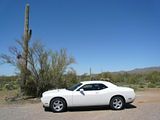 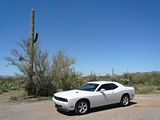  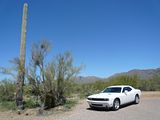 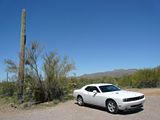 
|
